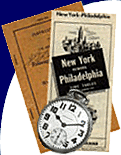

| home | articles | briefs | classifieds | flimsies | interchange |
 |
 |
||||||
|
|||||||
 |
RyPN Briefs March 24, 2006 previous brief ~ return to briefs index ~ next brief Ex LIRR Locomotive #399 Has A New Home In Riverhead The Board of Trustees of the Railroad Museum of Long Island (RMLI) are proud to announce that this past December, RMLI became the proud owner of ex LIRR 25 ton shop switching locomotive #399.This was the culmination of many phone calls, e-mails, and logistical jockeying of equipment to finally get this locomotive to the RMLI Riverhead site.
When RMLI got the word that #399 was ready to depart the LIRR in Jamaica for Riverhead, the real work began. RMLI had to get cranes to lift the locomotive, get a truck and lowboy trailer to transport the locomotive and make arrangements for a place to put the locomotive. This all came together in just a two week period. Tom Collins, RMLI Vice President, began work to get a crane to come to RMLI to do the lifting at Riverhead, NY. Tom and Bill Raynor, RMLI Site Manager, arranged for a truck with a lowboy trailer to relocate the locomotive.
RMLI wanted to put #399 behind the fence with the other locomotives on the west side of Griffing Avenue. This meant moving caboose #C-68 to a new location to make room for #399. RMLI decided to move #C-68 to the Museum's grounds on the east side of Griffing Avenue. Rich Gorddard, RMLI Trustee, began planning a spot to move #C-68 to. Prior to this move, #C-68 sat for years behind the fence on the west side of Griffing Avenue, near where the Museum's locomotives were located. With the much needed assistance of a backhoe on loan from Sypher Construction of Riverhead, the RMLI Riverhead crew of volunteers began planning and building a section of panel track which #C-68 will call her new home. Thanks to the volunteers it only took two days (actually two Saturdays) to install and build this panel track.
December 19, 2005 was the big day. The truck with the lowboy trailer from Sypher Construction arrived at the LIRR Morris Park rail yards on a cold and dreary morning to pick up #399. At approximately 8:30 AM, the LIRR wreck crew positioned their crane and crew for lifting #399 onto the lowboy trailer. The lift, loading and preparation for transport was then successfully completed.
As #399 was leaving Morris Park, everyone in the area stopped what they were doing and watched her leave the yard. It was like an old friend going into the sunset. But that was only the first half of the adventure. Three days later, it was time to place #399 in her new home and move #C-68 to her new home as well. On a frosty Thursday, December 22, 2005 at 8 AM, the crane supplied by Bay Crane of Long Island of Hicksville, NY, and #399 on its lowboy trailer arrived at the Riverhead site. The first order of business was to take #399 off the lowboy trailer and place it on the rail siding. Next, the crane loaded #C-68 onto the lowboy trailer for its short trip across the street to its new location. Finally, the crane was relocated and the #C-68 was unloaded onto its new piece of panel track. This effort to finally complete the very logistically involved tasks of moving both the #399 and #C-68 to their new locations in one day at RMLI was accomplished.
RMLI would like to say thanks to Charles Cicalo, LIRR Locomotive Shop Forman and System Wreckmaster, William Frentress LIRR System Asst. Wreckmaster, along with the wreck crew, who loaded #399 at Morris Park, without a hitch. The professionalism of the wreck crew was apparent as the #399 was expertly raised and then lowered on to the flatbed truck. Thanks also go to Dan Harringan of SPMP of Queens, who contacted Kenneth and Joseph Bernardo Jr. of Bay Crane of Long Island, who donated all the crane assistance at Riverhead for the lifting of #399 and #C-68. Dan also assisted and helped coordinate the lifts and moves at the Riverhead site. Thanks also to Lawrence Gillman of SPMP who supplied all the cable rigging needed for the crane lifts at Riverhead. Thanks go to Mark Sypher and Mike Farrar of Sypher Construction of Riverhead, who supplied the truck and flat bed trailer driven expertly by John Kosciuszko of Sypher Construction. In addition to supplying the truck and trailer, Sypher Construction stored #399 for several days till the locomotive could be unloaded at Riverhead. John then drove the truck with #399 to the RMLI Riverhead site, unloaded it with the help of Bay Crane under the watchful eyes of Charles Cicalo and William Frentress of the LIRR wreck crew. Then caboose #C-68 was loaded onto the flatbed, driven to the Museum's location, where Bay Crane unloaded it onto the panel track. RMLI invites everyone to stop by the Riverhead location and see the new addition to the museum's ever growing collection of historic equipment.
Locomotive Details |
|||||||||||||
Copyright © 1998 thru 2025, all rights reserved, contents may not be used without permission. |